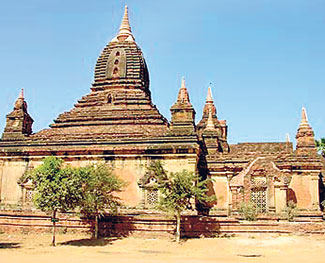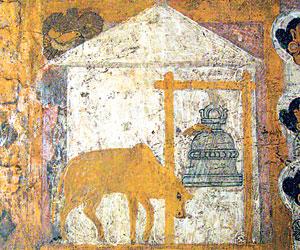One of the countries with a continuous memory of warm relations with Sri Lanka is Myanmar. These connections span over one thousand years. The best illustration of this is in the ruins of Bagan, the ancient capital of Myanmar and the cradle of its culture and civilization since the 11th century.
Bagan is a wonderful city which every Sri Lankan should visit. Its Buddhist monuments are great feats of construction in the ancient world, much greater than the construction of all (repeat all) the cathedrals of Europe whose erection had however been spread over nearly seven centuries - not the 150 years that the Bagan feat took.
Sri Lanka’s contribution towards the consolidation of the Bagan Empire in terms of religion, culture and civilization is attested to in the Myanamar historical chronicles, inscriptions, art and architecture as well as in Sri Lankan chronicles. What Sri Lanka gained from Myanmar is equally significant. Myanmar’s return gifts to Sri Lanka - the Amarapura and the Ramanna sects contributed a great deal to the religious, cultural and educational renaissance in the 18th and 19th centuries, the influence of which continues up to now. Let me give a few snapshots of this deep relationship.
 |
| Myinkaba Kubyauk-gyi Temple |
Some - by no means all - of the descriptions of our relationships are couched in pious tales of the miraculous. According to the Myanmar chronicles, the very first king of Bagan, Anawrahta (Anuruddha) made a miraculous trip to Sri Lanka in the 11th century to obtain a replica of the Tooth Relic from his friend Vijayabahu I. When Anawrahta received his request, he wished it replicated, and three more copies were miraculously produced.
King Anawrahta is said to have enshrined the original replica in the Shwezigon Pagoda in 1059 (archaeologists attribute it to the reign of Kyanzittha). The other three were enshrined in three other Pagodas attributed to Anawrahta, the most famous among them being Lawkananda Ceti. Situated on the river bank, Lawkananda is an ancient landmark near the old harbour where vessels from Sri Lanka, Arakan (Rakhine) and the Mon Ramannadesa anchored. The third pagoda stands across the river on Mt. Tangyi and the last on Mt. Tuywin.
Mahavamsa pictures
One of the most interesting sights in Bagan for Sri Lankans is the Mahavamsa episodes painted in the Myinkaba Kubyauk-gyi Temple in Bagan. This temple has pictorial illustrations of a large number of episodes covering the history of Buddhism in Sri Lanka up to the reign of King Vijayabahu, the contemporary of King Anawrahta and Kyanzittha. The murals relate events from Asoka’s life including his paying homage to Moggaliputta Tissa Thera. There is also a sequence of panels depicting the first three Buddhist Councils. The scenes in these pictorial illustrations include: the Buddha's visits to Sri Lanka, Emperor Asoka and King Devanampiyatissa, Asoka's message and the gifts for Devanampiyatissa's coronation, Devanampiyatissa's meeting with Thera Mahinda and Theri Sanghamitta’s arrival in Sri Lanka carrying the Bodhi tree.
On another wall are the scenes from the life of the Mahavamsa hero, Dutthagamini, namely: his elephant Kandula, he being given the name Abhaya (fearless), Abhaya wanting to go out and fight the enemy, when his father forbids him, him sending his father a woman's dress making the father angry, King Elara and the number of villages he administered and his justice bell which was rung by a cow when his son drove his chariot over a calf. Elsewhere on the walls are the scenes relating to the activities of King Vasabha, Siri Sanghabodhi and the physician-king Buddhadasa.
It should be remembered that Myanmar historical writings themselves began under the guidance of Sinhala Bhikkhus. The Myanmar chronicles such as the Mahasammatavamsa, Rajavamsa and Sasanavamsa were directly modelled after the Mahavamsa.
 |
| King Elara’s bell and cow |
There have been much political contacts between our two countries. The best connection was during the time of Vijayabahu when Myanmar helped us against the invading Cholas. Let me add a few more examples.
The premier historian of Myanmar, Gordon Luce has given evidence to show that there was a strong Sinhalese influence in the Bagan court during the reign of Narapatisithu. The latter's Queen Uchokpan was a Sinhalese princess, possibly the daughter of Parakramabahu.
In another reference in the Myanmar chronicle Hmaman Yasawinkyi, Alaungsithu of the 12th century, King of Myanmar (who was a contemporary of our Parakramabahu the Great) visited Sri Lanka. Alaungsithu married a daughter of the Sinhalese king and returned with an image of Maha Kassapa Thera who was highly venerated at the time in Sri Lanka.
(It was Maha Kassapa Thera who helped reform our sasana under Parakramabahu.)
But the political relations were sometimes antagonistic. The Culavamsa records that the Myanmar king caught sight of a letter addressed to the King of Cambodia in the hands of the Sinhalese envoys and suspecting that they were envoys sent to Cambodia, seized them and punished them. He also immediately stopped Sri Lanka's lucrative elephant trade with foreign countries, and captured the elephants, money and vessels of the Sinhalese envoys. But our major impact was in the realm of culture.
Sri Lankan monks’ monastery
complexes
Illustrating the general prestige of Sinhalese monks, a Myanmar inscription dated 1268 A.C. claimed that the deeds of merit by the donor were witnessed by all the Sri Lankan monks. An inscription near the Sinhalese style Stupa (No. 1113) in the vicinity of the Tamani complex of monasteries dated 1271 A.C. recorded by Tissa Maha Thera is indicative of this. It describes the mission undertaken by a Bagan monk to Sri Lanka carrying a message from the King of Bagan to the Sri Lankan King requesting Sri Lankan monk teachers to go to Myanmar to propagate the Buddha’s message.
During the reign of King Narapatisithu and the period immediately thereafter, several large monastery complexes that were built in Bagan were dedicated to Sinhalese monks. Inscriptions and ruins of several monasteries belonging to this period demonstrate that a large number of influential Sri Lankan monks taught Myanmar monks and samaneras.
The monasteries where the Sri Lankan monks resided are located south of the old city. The monks from Sri Lanka came to be known also as the Tamani group or sect and the monasteries that they resided in were known as Tamani monasteries. The largest monastery complex identified as Tamani comprises three large monasteries, located near each other.
The above is only a brief and admittedly scrappy set of descriptions on the intensity of our relationships. I only hope that as many Sri Lankans would travel there as they do to Buddha Gaya and to Thailand. The people of Myanmar are friendly and travel there is quite easy and the prices quite reasonable. |


